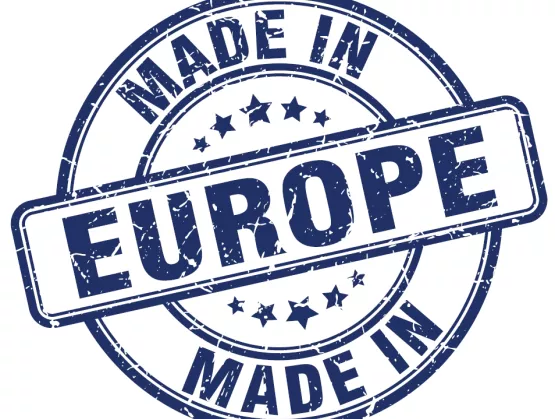
Last month, Germany published its National Industrial Strategy 2030, which sets strategic guidelines for a German and European industrial policy. The Strategy has drawn mixed feedback across Europe and internationally. What all stakeholders agree on is that the approach recommended in the strategy is not “business as usual” as it calls for a drastic change in the role Member States play in the European Union economy. SEMI has analyzed the paper from the viewpoint of European electronics manufacturing industry and provided the key points below to be considered by relevant actors, including the industry, academia and policymakers.
What does the Strategy mean for the electronics manufacturing industry in Europe?
The Strategy aims to expand European industries and wealth in the age of globalization, rapid innovation and rising protectionism by giving the EU and Member States more influence while protecting EU market economy principles. The key objective of the Strategy is to ensure the global competitiveness and industrial leadership of Europe and to strengthen its industries so that they account for 25 percent of Germany’s GDP by 2030, up from 23.4 percent today (at EU level, the target is 20 percent of EU GDP by 2030).
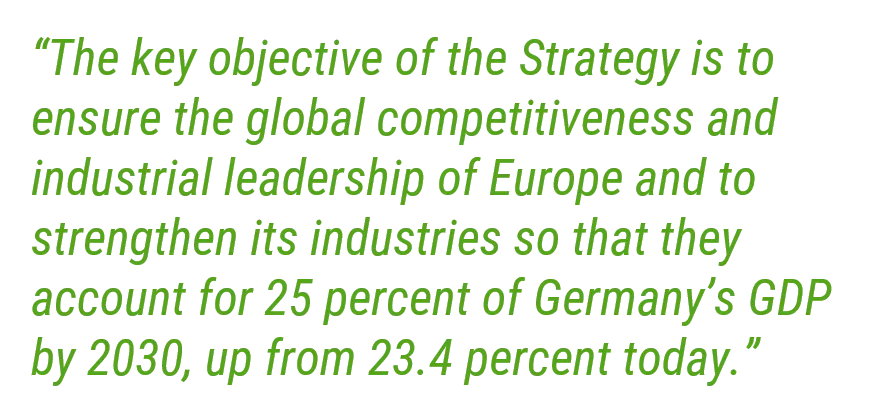 The Strategy underscores the vital importance of open markets and vigorous competition but recognizes that state intervention might be needed to protect the market economy, sustain innovation and maintain competitiveness when market forces fail to do so. The tools that enable a more active role for the state include funding to take (temporary) stakes in strategically important companies to prevent foreign acquisitions and subsidies to create large-scale industrial consortia. The Strategy also refers to measures such as reducing energy costs and taxes for businesses and enabling a more accommodative business framework in Europe. What’s more, it stresses the importance of acting as a European Union, rather than disconnected Member States to address the increasing competitive pressures around the world.
The Strategy underscores the vital importance of open markets and vigorous competition but recognizes that state intervention might be needed to protect the market economy, sustain innovation and maintain competitiveness when market forces fail to do so. The tools that enable a more active role for the state include funding to take (temporary) stakes in strategically important companies to prevent foreign acquisitions and subsidies to create large-scale industrial consortia. The Strategy also refers to measures such as reducing energy costs and taxes for businesses and enabling a more accommodative business framework in Europe. What’s more, it stresses the importance of acting as a European Union, rather than disconnected Member States to address the increasing competitive pressures around the world.
The Strategy cites countries with abundant financial and human resources and governments capable of supporting the development of key technologies. In this light, previous U.S. administrations are seen a key enabler in the development of gigantic Internet companies, and the current administration’s protectionist “America First” policy extends that enabling approach to more traditional industries such as materials. The Strategy highlights similar examples in China and in the sectors including artificial intelligence (AI), electronics, advanced and networked machines and robotics. Critically, the Strategy points to the need for a European policy that gives the state more influence as an enabler of economic growth.
The Strategy acknowledges large-scale businesses and high-level of investment as crucial components of economic competitiveness and urges European regulators to look beyond national and EU borders when evaluating market dynamics and opportunities. It calls for legal reforms that allow the creation champions from Europe by permitting large-scale mergers, especially in strategic sectors facing serious competitive challenges at the global level but saddled by extremely high capital and R&D expenditures.
Does the new Strategy align with the needs of the European electronics manufacturing industry?
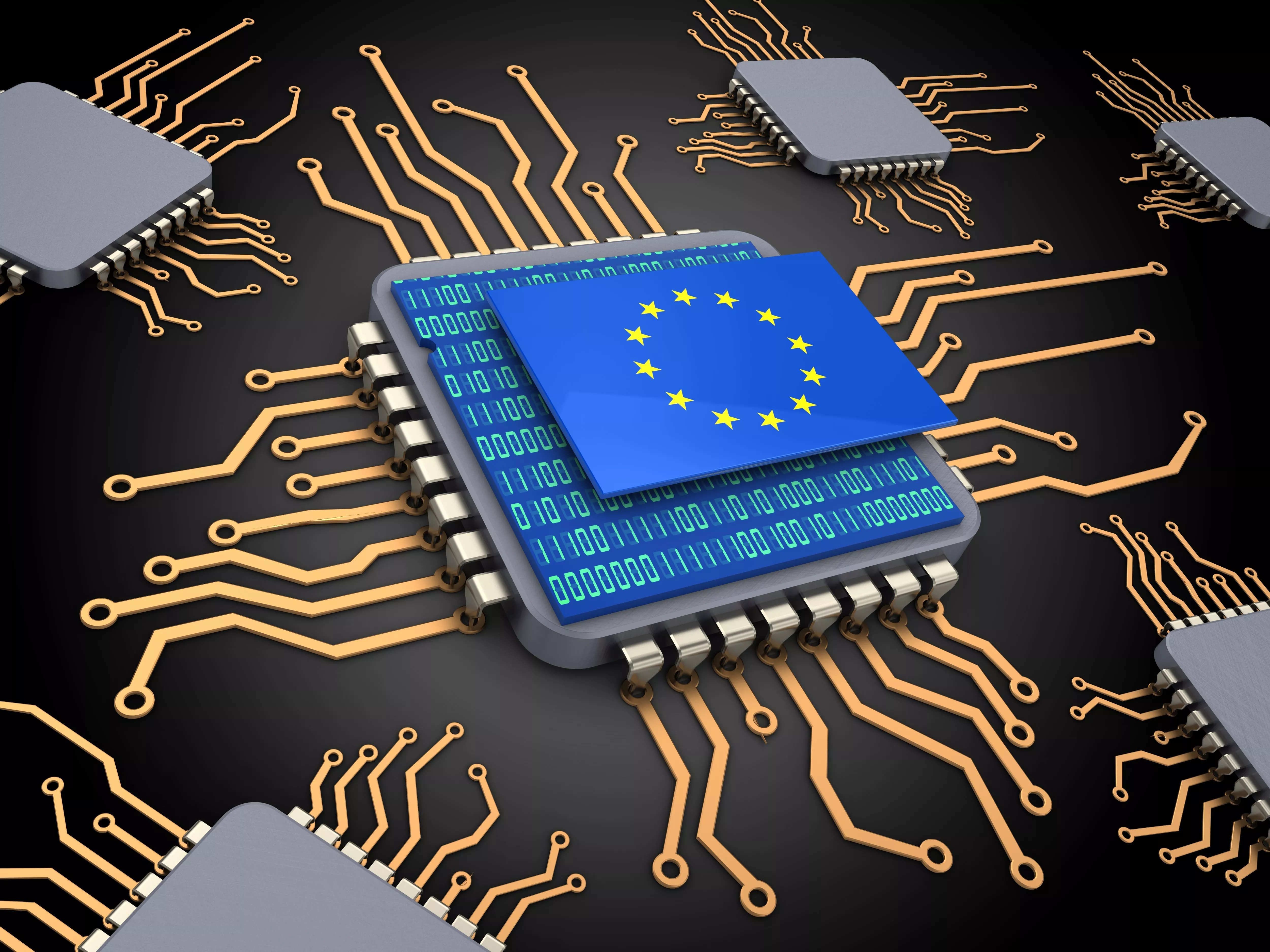 Firstly, the new Strategy is in draft form and invites stakeholders to participate in the discussion. The Strategy is a step to support governments both at the EU and national levels in better understanding the key role of a dynamic manufacturing sector in competitiveness, innovation, sustainability and the well-being of citizens. The recently communicated industrial policies at the EU and national levels dovetail with this approach. It is also encouraging that the Strategy calls for a unified European effort to address competitive pressures from around the world.
Firstly, the new Strategy is in draft form and invites stakeholders to participate in the discussion. The Strategy is a step to support governments both at the EU and national levels in better understanding the key role of a dynamic manufacturing sector in competitiveness, innovation, sustainability and the well-being of citizens. The recently communicated industrial policies at the EU and national levels dovetail with this approach. It is also encouraging that the Strategy calls for a unified European effort to address competitive pressures from around the world.
The Strategy’s overall situation analysis and problem statement are, by and large, appropriate. In sectors with high capital expenditures, the support and early involvement of government along with large businesses and high investment levels are instrumental in competitiveness and global leadership. The analysis makes the valid points that underpinning innovation and competitiveness is one of state’s shared responsibilities and that European manufacturers face rising challenges by global players supported by heavy government-backed investment. It is also clear that Europe needs to develop a focused strategy, re-identify its strengths and invest in key sectors with the aim of expanding strategic value chains in Europe.
Acknowledging the fact that the strict European approach on state aid could be reviewed with an eye toward enabling a level-playing field globally is a step in the right direction. Lastly, Europe should, of course, be alerted to unfair practices of competitors that distort markets, seek fair play and competition at the global level, and encourage equal market access for all companies in every region around the world.
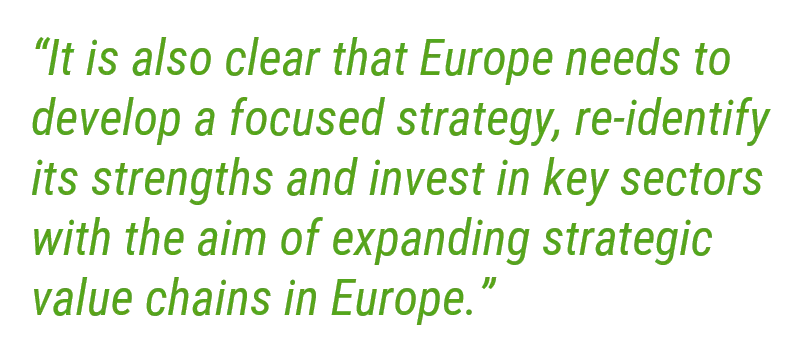 The Strategy, nevertheless, has many proposals that are not clear how they are rooted in the realities of the European electronics manufacturing sector. First, the European industrial ecosystem is very heterogeneous. It includes agile SMEs, start-ups, traditional family-owned companies, large global players and world-class research centers and innovation hubs. Europe’s key innovative strength is the collaboration among them. A state-driven industrial strategy emphasizing the creation of gigantic players could hamper Europe’s ecosystem in the long run. Instead, Europe’s industrial strategy should strengthen its heterogeneous ecosystem and government support is needed to bolster cross-border collaboration between small and large players and R&D centers.
The Strategy, nevertheless, has many proposals that are not clear how they are rooted in the realities of the European electronics manufacturing sector. First, the European industrial ecosystem is very heterogeneous. It includes agile SMEs, start-ups, traditional family-owned companies, large global players and world-class research centers and innovation hubs. Europe’s key innovative strength is the collaboration among them. A state-driven industrial strategy emphasizing the creation of gigantic players could hamper Europe’s ecosystem in the long run. Instead, Europe’s industrial strategy should strengthen its heterogeneous ecosystem and government support is needed to bolster cross-border collaboration between small and large players and R&D centers.
The EU is already a leading model with its public-private partnerships and there is no reason for a drastic change in Europe’s industrial policy. EU’s funding instruments such as Horizon 2020, ECSEL Joint Undertaking, Erasmus+ Sector Skills Alliances, just to name a few, are successful. The recent approval of the Microelectronics IPCEI (Important Projects of Common European Interest) by the European Commission, although seriously delayed, is appreciated as it is based on a sound legal, economic and strategic analysis and a clear set of criteria. Simply put, the European industrial ecosystem is too heterogeneous to be managed by a state-driven industrial policy that is overly focused on large corporations and overlooks the importance of agility and collaboration in the age of globalization and digitization.
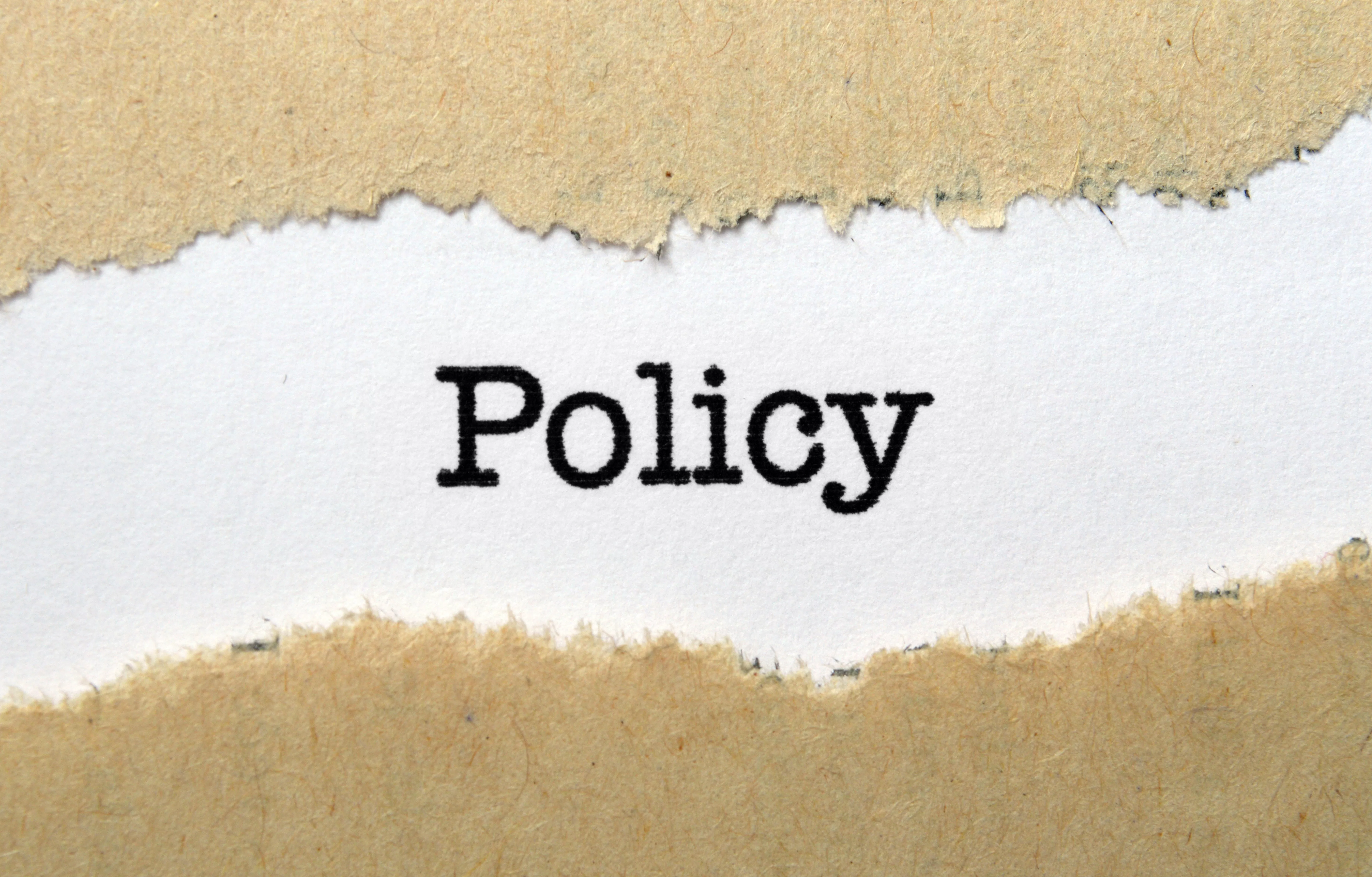 Second, it is worrying that the Strategy proposes an approach that would harm small players and consumers in the long run by creating monopolies. Competition is good for businesses and society, as it raises the bar constantly, and provides consumers with the best possible prices, quantity, and quality of goods and services through continuous innovation. Protecting European private actors from competition and prioritizing state-supported large businesses would ultimately reduce competitive pressures and therefore the need to adapt and innovate continuously.
Second, it is worrying that the Strategy proposes an approach that would harm small players and consumers in the long run by creating monopolies. Competition is good for businesses and society, as it raises the bar constantly, and provides consumers with the best possible prices, quantity, and quality of goods and services through continuous innovation. Protecting European private actors from competition and prioritizing state-supported large businesses would ultimately reduce competitive pressures and therefore the need to adapt and innovate continuously.
Third, the Strategy over-emphasizes the importance of state aid practices of external competitors. Europe needs a more comprehensive and sophisticated industrial policy analysis. Clearly, the different approach between the EU and its competitors is not limited to state aid and competition law. Europe’s environment, sustainability, employment, freedom of contract, intellectual property, data protection policies, just to name a few, differ from its competitors. Therefore, a narrow comparative industrial policy analysis neglecting the differences between Europe and its competitors has little to offer.
Fourth, many in Europe would agree that a strong state is needed, but this strength should be based on a forward-looking framework and a set of clear, strict and comprehensible criteria. In this light, a modern industrial policy should prioritize a) investment in physical and digital infrastructure connecting Europe, b) modernization of education in high-tech and up-skilling; c) legal coherence and certainty and a lean regulatory framework; d) functioning competition based on market forces; and e) better branding of Europe across the world.
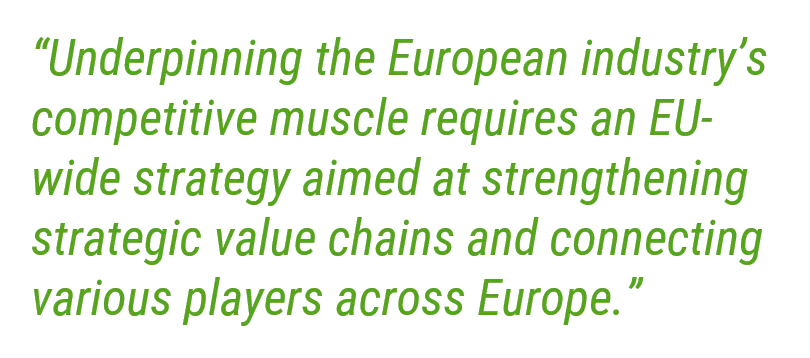 In short, while the Strategy’s overall goal to increase the competitiveness of European industry and its problem statement are appropriate, its proposals are not clearly rooted in the realities of the European electronics manufacturing sector. Underpinning the European industry’s competitive muscle requires an EU-wide strategy aimed at strengthening strategic value chains and connecting various players across Europe.
In short, while the Strategy’s overall goal to increase the competitiveness of European industry and its problem statement are appropriate, its proposals are not clearly rooted in the realities of the European electronics manufacturing sector. Underpinning the European industry’s competitive muscle requires an EU-wide strategy aimed at strengthening strategic value chains and connecting various players across Europe.
Specializing and investing in key application segments, where the EU enjoys a central position at the global level, is crucial to helping the European industry hold its ground. In addition, what Europe really needs is to make better use of its globally admired public-private partnership models and funding tools, enable a business-friendly regulatory framework and invest in infrastructure, education and up-skilling. The rest is the decision, action, responsibility and liability of European businesses.
This analysis is a step by SEMI to encourage discussion about how to enable a modern industrial policy in Europe. The next European elections will take place in May 2019 and it is crucial that the EU and Member States understand what the European electronics manufacturing industry really needs for public policies underpinning growth, competitiveness and sustainability.
Emir Demircan is senior manager, Advocacy and Public Policy, at SEMI Europe. He can be reached at edemircan@semi.org.